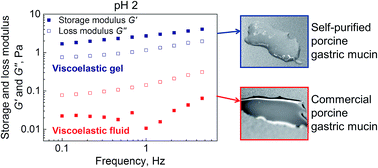An optimized purification process for porcine gastric mucin with preservation of its native functional properties†
Abstract
Purified gastric mucins are currently used for a wide range of applications e.g. as a model system for native mucus, as lubricants or antiviral/antibacterial supplements. However, commercially available porcine gastric mucins (PGM) do not exhibit gel-forming properties and show only greatly reduced anti-viral/anti-bacterial activity. Thus, we established a robust purification process for PGM, maintaining its desired properties such as lubricity, gel formation and the selective binding of molecules. We optimized the process in terms of yield and productivity and evaluated the influence of different buffer conditions on mucin quality. Cross-flow filtration using 100 kDa membranes was introduced and optimized to pre-concentrate the mucin solution prior to size exclusion chromatography. A conductivity of less than 100 μS cm−1 after diafiltration was found to be crucial for gel formation. The mucin yield of the optimized process was 66%. The scale-up resulted in a productivity of 0.15 mg purified mucin per mL crude mucus an hour. In total, approx. 65 mg mucin could be purified from one pig stomach. Tribological studies, rheological measurements and co-localization experiments confirmed the retained functionality of purified mucin in terms of lubricity, gel formation and binding interactions with charged molecules, respectively.


 Please wait while we load your content...
Please wait while we load your content...